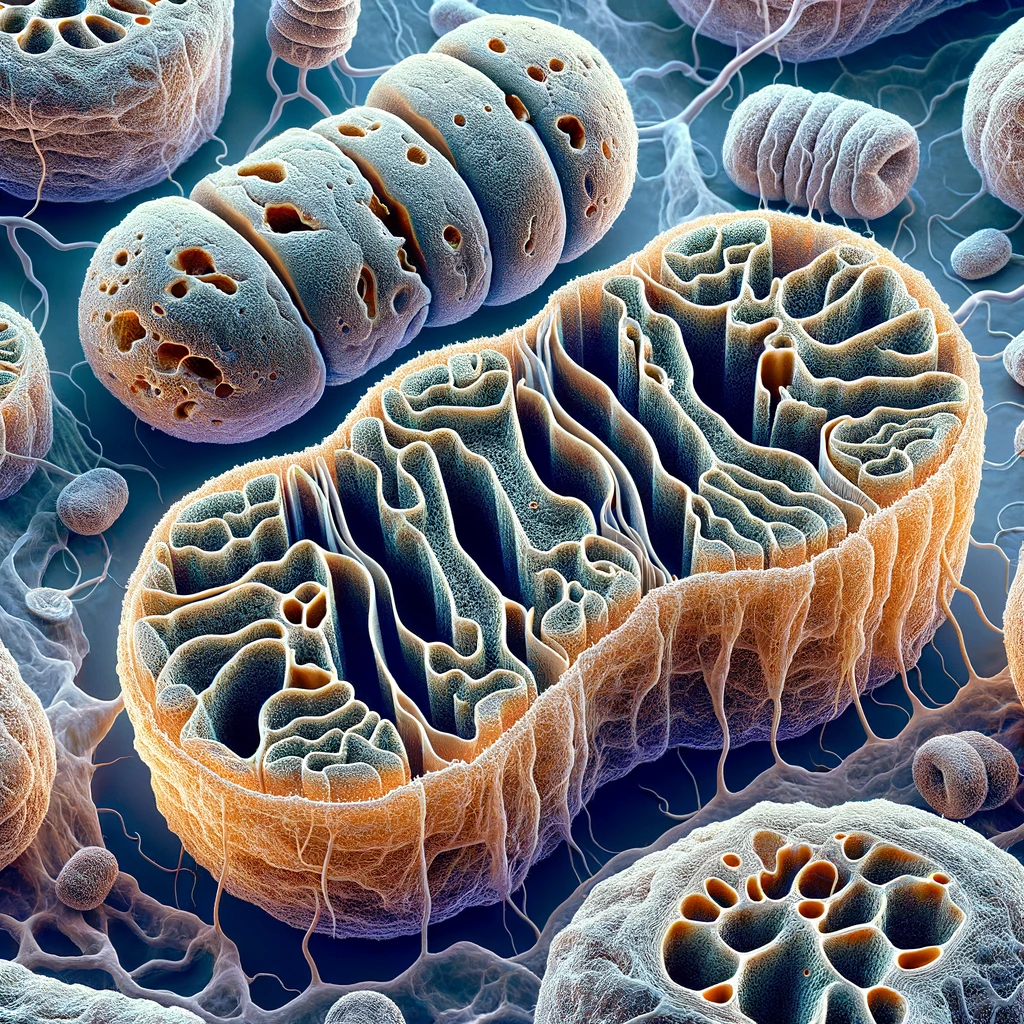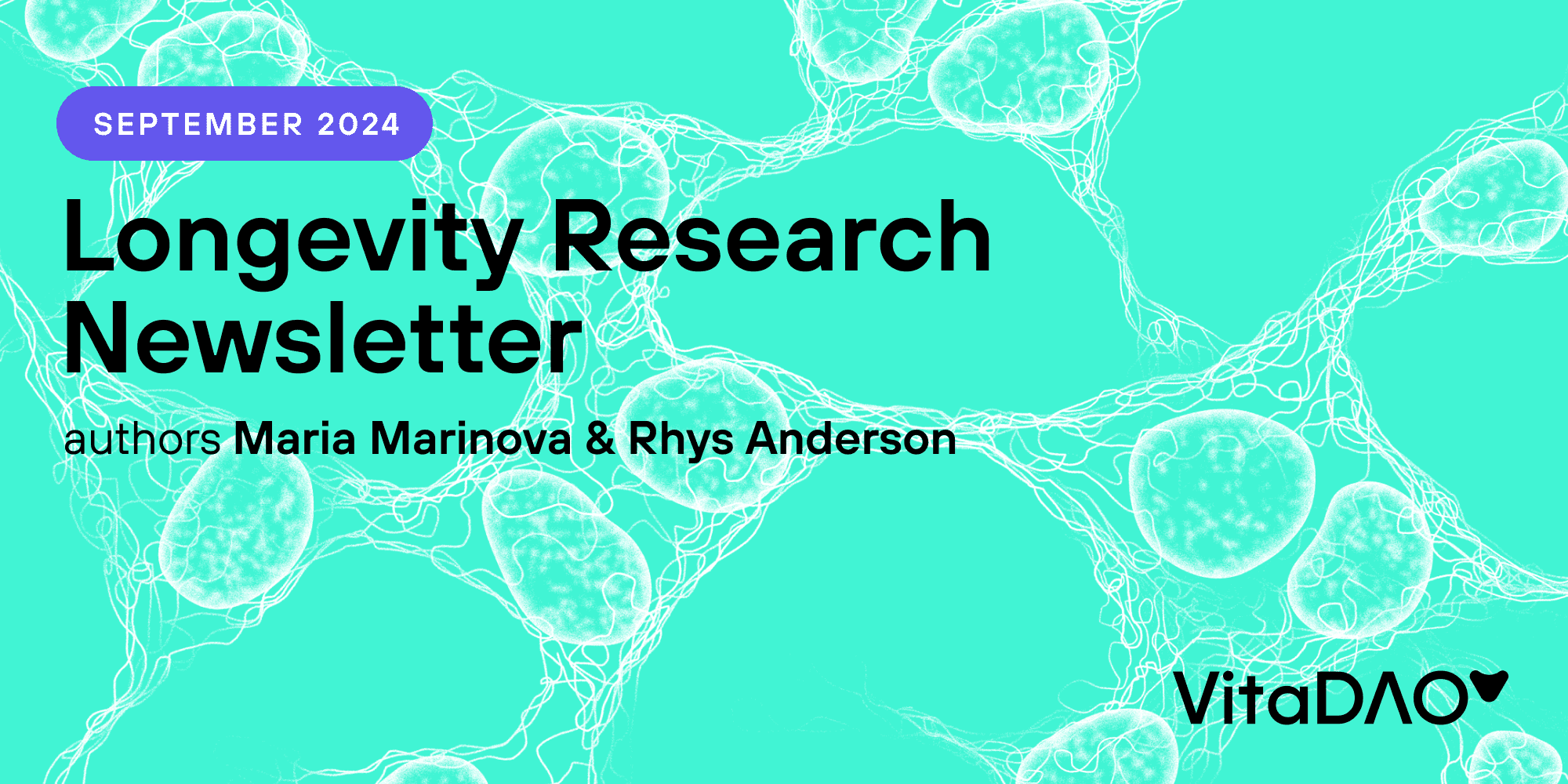
March 2024 Longevity Research Newsletter

March Longevity Research Newsletter
Introduction
Welcome back Vitalians!
An article on VitaDAO has been published in Nature Biotechnology! It is a case study on the potential of DAOs for funding and collaborative development in the life sciences. In this article, the authors explore VitaDAO’s role in revolutionizing life sciences funding through blockchain technology.
In this month's edition, we delve into the fascinating intersection of regeneration and aging biology, exploring how insights from the natural world's remarkable regenerative processes can illuminate the pathways to healthier aging. While some creatures in nature can astonishingly regenerate lost limbs or damaged organs, humans have much more limited regenerative capabilities, primarily resulting in scar formation rather than true regeneration.
We are excited to bring you an interview with Prof. Nicole Ehrhart, the director of Columbine Health Systems Center for Healthy Aging at Colorado State University. She shares her fascinating journey into longevity research, initially inspired by the limitations in tissue regeneration in higher mammals. This led her to explore aging biology, where she recognized a significant intersection with her prior work in tissue regeneration. Dr. Ehrhart's research leverages her background in veterinary medicine and surgical oncology, focusing on naturally occurring disease models in animals to improve clinical outcomes in both humans and canines. She emphasizes the importance of multidisciplinary collaboration in advancing aging research and highlights the unique benefits of using companion dogs in clinical trials to accelerate the development of age-reversal therapies.
Longevity Literature Hot Picks

Preprint Corner in collaboration with

The Longevist is a preprint overlay journal spotlighting the most promising longevity studies each quarter.
And just like that, Q1 is over! Check out these latest preprints, which have all been entered into the 1Q24 longlist to be in the running to receive a coveted place in The Longevist. As always, you can refer preprints for consideration in The Longevist.
Rejuvenation of aged oocyte through exposure to young follicular microenvironment
Comparative analysis of mouse strains for in vivo reprogramming
Association between prescription drugs and all-cause mortality risk in the UK population

cGAS-STING is responsible for aging of telomerase deficient zebrafish
Senolytic CAR T cells reverse aging-associated defects in intestinal regeneration and fitness
Machine learning predicts lifespan and underlying causes of death in aging C. elegans
A torpor-like state (TLS) in mice slows blood epigenetic aging and prolongs healthspan
Published Research Papers

Depleting myeloid-biased haematopoietic stem cells rejuvenates aged immunity
Aging of the immune system involves a shift from lymphoid-supporting to myeloid-biased hematopoietic stem cells, leading to reduced adaptive immunity and increased inflammation. This exiting new study shows that eliminating myeloid-biased cells in aged mice rejuvenates their immune system.

Formation of memory assemblies through the DNA-sensing TLR9 pathway
Interested in how memory works at the molecular level? Check out the News & Views from Ben Kelvington and I in Nature on this exciting paper from Jelena Radulovic that describes links between DNA damage, innate immunity and memory!
Epigenetic aging of human blood cells is influenced by the age of the host body
The study reveals that the age of a stem cell transplant recipient affects the epigenetic aging of donor cells, accelerating it in older recipients and decelerating it in younger ones, indicating the recipient's body age influences transplanted cell aging.
The CALERIE™ 2 trial on caloric restriction (CR) showed mixed effects on telomere length attrition over two years, with initial increased attrition in CR participants that lessened in the second year, suggesting a complex interaction between CR and telomere health that warrants further study.
Can Viagra treat Alzheimers? The study analyzed millions of insurance claims revealing 30-54% reduced prevalence of disease among those taking drug. In brain cells from AD patients, drug lowered levels of neurotoxic tau proteins and inflammation.
The common marmoset as a translational model of age-related osteoarthritis
The study validates common marmosets as a model for human age-related knee osteoarthritis (OA), showing that geriatric marmosets display OA characteristics similar to humans, including increased prevalence and severity with age, and notable sex differences.

A small-molecule TNIK inhibitor targets fibrosis in preclinical and clinical models
Using AI, researchers discovered TNIK as a target for treating idiopathic pulmonary fibrosis (IPF), leading to the development of the anti-fibrotic drug INS018_055. This drug showed promising anti-inflammatory and anti-fibrotic effects in vivo, with its safety confirmed in phase I trials.
Ergothioneine promotes longevity and healthy aging in male mice
Ergothioneine (ERGO), when supplemented daily in male mice, extended their lifespans and reduced age-related frailty and cognitive decline, pointing to its beneficial role in promoting healthy aging through multiple biological pathways.
CheekAge: a next-generation buccal epigenetic aging clock associated with lifestyle and health
CheekAge, a new epigenetic aging clock developed from cheek swabs and lifestyle/health data of 8,000 adults, accurately predicts age and correlates with health factors like BMI and smoking. It is non-invasive, validated across different conditions and available through a free online tool.

Intermittent rapamycin treatment in mice extends lifespan with fewer side effects than chronic treatment, although chronic treatment more effectively improves overall healthspan. Both approaches similarly benefit lifespan in males and mitigate certain age-related conditions, but chronic treatment shows a slight survival advantage in females.
EOD intermittent fasting reduced aging-related frailty in male mice by decreasing energy intake and enhancing renal hydrogen sulfide production, improving various health measures. However, it showed minimal benefits in females, indicating gender-specific effects.
A molecular index for biological age identified from the metabolome and senescence-associated secretome in humans
The Healthy Aging Metabolic (HAM) index, comprising 25 metabolites, effectively predicts healthy aging across genders and races. Key metabolites driving aging and elevated inflammation markers in rapid agers were identified, suggesting metabolic pathways significantly influence biological aging.
An Updated Prioritization of Geroscience-Guided FDA-Approved Drugs Repurposed to Target Aging
Geroscience focuses on delaying aging-related diseases by targeting aging mechanisms, aiming to extend lifespan and healthspan. Recent updates add bisphosphonates, GLP-1 receptor agonists, and beta blockers as promising gerotherapeutics.
Multi-omics characterization of partial chemical reprogramming reveals evidence of cell rejuvenation
Chemical reprogramming rejuvenates aged mouse fibroblasts by altering their molecular profile and reducing biological age, particularly by enhancing mitochondrial function. This approach suggests a promising avenue for reversing aging effects in vivo, highlighting the need for further investigation.
Mitophagy defect mediates the aging-associated hallmarks in Hutchinson–Gilford progeria syndrome
Mitophagy defects contribute to the premature aging in Hutchinson-Gilford progeria syndrome (HGPS) by impairing mitochondrial function. Using UMI-77 to induce mitophagy improved aging markers in HGPS and aged mice.

Knocking out the Tert gene in endothelial cells (ECs) of mice induced signs of aging such as senescence and tissue hypoxia, leading to leaky blood vessels, cognitive impairments, and decreased muscle endurance. The study highlighted a shift towards glycolysis for energy, due to reduced mitochondrial function, even in the presence of normal telomere lengths in certain tissues.
Published Literature Reviews, Hypothesis, Perspectives and more
Translation is an emerging constraint on protein homeostasis in ageing
This review explores how the aging process disrupts the correlation between transcript levels and protein products, influenced by diminished protein synthesis capacity and a decreased ability of aging cells to adapt their proteomes to stress, potentially due to factors like reduced ribosomal function and increased mistranslation.
Time is ticking faster for long genes in aging
Recent studies have shown that with age, longer genes tend to show reduced expression across various species and cell types, potentially due to polymerase stalling from DNA damage. Here the authors term this phenomenon gene-length-dependent transcription decline (GLTD) and also describe its role in age-related diseases.
Pharmacological interventions in human aging
A comprehensive database called AgingDB has been created to consolidate information on over 130 clinical trials focused on pharmacological interventions in aging, covering areas like glucose homeostasis, metabolic interventions, senolytics, and mTOR inhibition. This resource aims to make it easier for individuals to find and stay updated on trials targeting aging, marking a significant shift towards treating aging as a manageable medical condition.

Expanding our thought horizons in systems biology and medicine
Buck Institute “Jennifer Lovejoy expands our thought horizon regarding systems biology RE: the importance of measuring behavior and exposome, both new frontiers in research on aging”.
Decoding lifespan secrets: the role of the gonad in Caenorhabditis elegans aging
The gonad is heavily implicated in C. elegans aging, as removing its proliferating stem cells or inducing stem cell quiescence through starvation significantly extends lifespan, a phenomenon also seen in other nematodes. This review explores the mechanisms behind gonad-mediated lifespan extension, including lipid signaling and transcriptional changes, and suggests that insights from these studies could enhance our understanding of aging's mechanisms and evolution across different species.
Hungry for biomarkers of aging
The geroscience hypothesis, which suggests that interventions targeting biological hallmarks of aging could delay or prevent age-related diseases and disabilities, has sparked significant interest due to early evidence that these mechanisms are modifiable. This approach highlights the necessity and potential challenges of developing and using biomarkers of aging to optimize human health in a transformative way.

Job Board

The Kapahi lab at The Buck Institute has 2 postdoc positions available - using bioinformatic approaches from flies and humans to study the role of circadian clocks and nutrient-responsive pathways influencing eye and neuronal degeneration using flies and conserved orthologs from humans
Looking for a PhD position? Retro might have something in store for you!
Retro College is now accredited in both the EU and USA to grant PhDs.
They have welcomed the first 2 students, and have openings for 3 more.
Postdoc position in the Singh Lab at UCSF to study aging, age-related diseases, and diapause using multi-omics in the African killifish.
News and Media

Longevity: how science is pushing the boundaries for the first 150-year-old human
Using Ultrasound to Assist Gene Therapy
This approach opens up heart muscle cells for potential therapies.


‘Ageing isn’t inevitable’: The 100-Year-Life co-author on how to live well for longer
Daniel Ek's new bet on longevity
“The upper echelons of Stockholm society will soon have a new place to spend their money: a luxurious longevity clinic half-owned by the founders of Spotify.”
How to ‘switch on’ your anti-ageing genes – and live longer
A call to arms to save the genome
By Biotech Explorers powered by a Bioreactor-Grown Mitochondrial Transplantation - a technique that our parent firm Mitrix Bio
Resources

In the publication section above, we introduced AgingDB - a new database of pharmacological trials targeting aging - and here we’d like to share another list of aging clinical trials from AgingBiotech.info!
New Aging Books!
From Nobel Prize winning Biologist Venki Ramakrishnan:
Why We Die: The New Science of Ageing and the Quest for Immortality (Hardback)
A review of the book from Prof. Charles Brenner.

And, Andrew J Scott’s new book “The Longevity Imperative: Building a Better Society for Healthier, Longer Lives” is out in the UK and soon available in the US.

David Sinclair et al., previously published a paper on The economic value of targeting aging - now check out a YouTube video explaining these ideas!
Prizes

The Million Molecule Challenge, supported by The Longevity Prize, is still open and accepting applications - submit a compound and we will finance the testing at the Ora Labs. There’s no jury for this one, the winners are awarded based on results alone.
Want to know how it’s going so far? See Leaderboard here.
Conferences

8-9th April, Valencia, Spain
Midwest Aging Consortium Aging Research Symposium
28-30th April, Columbus, OH
8-9th May, Lisbon, Portugal
10-11th May, Berlin, Germany
4th - 6th September
Tweet of the Month

For geroscientists out there, why do we call them "clocks?" Clocks tell time of day. Calendars tell days, months, and years. Clocks tell us what time to eat and sleep. Calendars tell us our age. They should be epigenetic or proteomic calendars.
Podcasts and Webinars

NUS Medicine’s Healthy Longevity Webinar Series
Dr. Jean Hebert: Progressive Brain Tissue Replacement and How we Beat Aging!
STARTALK: Is Aging a Disease? Epigenetics with David Sinclair
The Optispan Podcast with Matt Kaeberlein: Rapamycin's SURPRISING Effects on Aged IMMUNE SYSTEMS
Interview with Professor Nicole Ehrhart
Bio: Dr. Nicole Ehrhart, VMD, MS, directs the Columbine Health Systems Center for Healthy Aging at Colorado State University. Holding the Ross M. Wilkins M.D. Limb Preservation Foundation University Chair in Musculoskeletal Oncology and Biology, she is also a board-certified veterinary surgeon and a leader in both national and international surgical organizations.
What inspired you to enter longevity research?
I am a clinician scientist who utilizes a wide spectrum of animal models in aging research but I focus on naturally-occuring disease models to aid in translation of discovery to clinical application The first phase of my research career was focused on tissue engineering and regenerative medicine, ie combining synthetic or biologic scaffolds, signals and progenitor cells to regenerate tissue following trauma, infection or tumor surgery. One of the questions that drove my curiosity was why humans and other higher mammals have such limited tissue regeneration capacity as compared to creatures such as salamanders, for example , who can regenerate entire limbs following an amputation. Higher mammals can achieve a small amount of tissue regeneration, but beyond this limited response they simply form scar tissue instead of replacing native tissue. Through my work and others, we learned that a fundamental reason why higher mammals such as humans, horses, dogs etc. do not regenerate large amounts of native tissue following acute injury was due to exhaustion of the tissue stem cell pool. I spent a lot of time working on strategies to “rejuvenate” tissue stem cells. When the cellular hallmarks of aging were first described, I was fascinated to learn that stem cell exhaustion was one of the fundamental drivers of cellular aging. There was an intersection I hadn’t been aware of between my work and what was, at the time, the rather nascent field of aging biology. It dawned on me that the same strategies we were using to boost tissue regeneration following acute tissue loss could potentially be applied to the slow, insidious loss of tissue volume or function associated with aging. I could see that the impact potential was huge. Not everyone suffers from acute tissue loss but every one of us ages and loses tissue function and mass along the way, just very slowly. That was the inspiration to enter longevity research.
Which of the current theories of ageing do you think are the most convincing?
This is a difficult question to answer because we continue to refine our knowledge about aging biology daily. The field is literally exploding with new data that are rapidly shaping and re-shaping our understanding. These advancements in our knowledge are not linear and iterative. Therefore, instead of concerning ourselves with which theory is most convincing, we need to understand that they each represent parts of larger story which is yet incomplete. We are still the blind men trying to make a theory about the entire elephant but we only have perspective on separate parts of the whole, to use a common analogy. I believe we should be focusing on the intersections of the different theories to see what bigger picture is beginning to crystalize.
How has the field changed since you started?
Geroscience has gained more recognition as a distinct field of study, leading to increased funding opportunities from government agencies, private foundations, and the biotech industry. This has allowed researchers to pursue more ambitious projects and collaborations. Progress in identifying new and refined biomarkers of aging, will be crucial for assessing longevity interventions. This area has also progressed since I entered the field.
What mistakes do you think the longevity field has made?
In the past, there has been a tendency to search for single interventions or "magic bullets'' for extending lifespan, overlooking the complexity of aging processes. This approach does not take into account the interrelatedness of the drivers of aging. In addition, there has been too much emphasis on data collected from traditional laboratory animal models such as fruit flies, worms and mice. This approach has resulted in extremely important mechanistic and proof of concept data that has advanced our overall knowledge greatly. However, as exciting as these results are, the models do not at all mimic the complexity of human aging. When we use these data alone to move forward with human clinical trials, it's common for such interventions to fail or, even worse, have unintended negative consequences. This has led to a lot of disillusion and loss of credibility in aging biology. Further investment to successfully translate these discoveries becomes too high risk and many exciting and potentially highly efficacious interventions are abandoned at that point. To solve this problem, we need to build a better bridge across the huge translation gap. Investing in this niche will better inform go/no-go decisions for new longevity therapeutics and is a powerful, cost-effective way to de-risk and accelerate gerotherapeutics.
Is ageing a disease?
Modern medicine is based upon detection and subsequent diagnosis of a specific condition which is then treated. However, changes in our cells and tissues are occuring with the passage of time. We call this “aging”. Older bodies are made up of older cells that are less and less able to repair from the wear and tear of everyday function or damage. Subsequently, when enough unrepaired damage accumulates within an organ or body system, the system fails to work properly. We recognize this end dysfunction as a “disease”. So maybe the question is: are accumulating changes that are upstream of the onset of a disease diagnosis also part of the “disease”. My answer to this is “yes”. Aging is a modifiable process that occurs over time and we should not wait until the dysfunction is so severe so as to put a specific name on it to treat it.
Given your unique background in veterinary medicine and surgical oncology, how does this perspective enrich your approach to aging research, and are there specific insights or methodologies from these fields that can notably advanced the study of aging biology?
The direction forward must also include a way to study aging on an accelerated timeline,which brings us to the topic of model organisms in research. Laboratory mice – the most common species involved in testing the safety and effectiveness of a drug prior to human clinical testing – are astoundingly poor models of human aging. They live in highly controlled environments, eat identical diets and are genetic twins of one another. This is a far cry from humans, who are genetically diverse and have a myriad of social, economic, environmental and lifestyle behaviors that influence their health outcomes. Consequently, a mouse-to-man approach for new drugs has historically been unsuccessful. Primates, our closest genetic relatives, are an alternative model in which to study age reversal drugs, but primates also have long lives, and when in a laboratory environment, they are not subject to the same variations in environment, exposures and habits as human populations. However, there is another promising approach: a species that lives among us, shares our environments, lifestyle habits and social structures. They develop the same diseases of aging as humans, are genetically diverse and have access to well-established heath care systems and interventions, yet they age much more rapidly than humans. Enter the companion dog. Pet dogs have coevolved with humans and represent a unique animal population that could be a powerful bridge to accelerating the development and approval of age reversal drugs in humans. There are millions of companion dogs in the United States, for example, and the quality of veterinary care has paralleled human medical care, such that there is a large population of dogs living to old age and developing diseases of aging naturally, just as humans do. The development of well-designed clinical trials to show health span extension in family dogs would need to include all the ethical and safety considerations of human clinical trials. Studies such as these are conducted while the pet continues to live out their daily life in their home with their family – while the medical team conducting the trial carefully ensures that their health and well-being are maintained. Pet owners can choose if they wish to voluntarily enrol their companion dogs in a study and participate in citizen science, collaborating with researchers to share observations, thereby cocreating and contributing to scientific outcomes. Engaging companion dogs in health span clinical trials provides a chance to enhance their wellbeing and life span, not only for their benefit, but also as a more accurate predictor of the effectiveness of health span-extending drugs in human populations. Given the identical nature of most age-related diseases between dogs and humans, and the shorter canine life span, the overall effect would be the acceleration of meaningful health span extension therapies for humans that our animal companions will benefit from too. In my opinion, well designed, placebo controlled, multi-institutional clinical intervention studies in companion dogs; which incorporate all the safety and ethical considerations that are employed in human clinical trials yet cost a fraction of the amount for a similar human clinical trial, are a vastly underutilized resource.
As the director of Columbine Health Systems Center for Healthy Aging how do you foster collaboration across different fields to advance aging research and are there particular focus areas that are emphasised?
I truly believe that the answers to the most challenging human issues, such as aging, lie at the intersections between disciplines. Academia is very good at drilling down deeply within specific science disciplines, but we have sometimes failed to bring the lens of multiple scientific domains to bear on a single challenge. Colorado State University’s Center for Healthy Aging unites and facilitates interdisciplinary research teams across multiple scientific fields to address the grand challenge of global aging. Our work creates research teams comprised of many disciplines- from the behavioral sciences to engineering to medicine. My personal passion and focus is to find novel ways to bridge the gap between discovery in geroscience and meaningful healthspan interventions that will impact how we, and the creatures we share our world with, can live our best lives.
Outro
We appreciate you sticking with our research newsletter for another month and hope the content we curate is useful in helping you to keep up-to-date with all the exciting longevity-related developments. See you next month!
Further Reading
How excess niacin may promote cardiovascular disease


